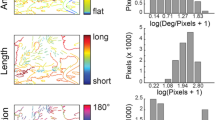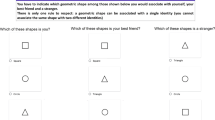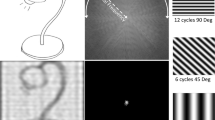Abstract
The evaluation of angular vs. curved forms has a long history in psychology but few of the many studies conducted have examined actual degree of angularity. In two experiments, we present observers with randomly positioned and randomly oriented texture displays of angles viewed within a circular frame. The angle conditions varied from 0° to 180° in 20° increments, covering the entire spectrum of possibilities including acute, obtuse, right, and straight line angles. In Experiment 1, 25 undergraduates rated the perceived beauty of these displays. In Experiment 2, the same stimulus set and procedure were used with 27 participants instead judging perceived threat. Based on the findings in the literature, we predicted that sharper angles would be judged less beautiful and more threatening. The results were mostly confirmed. Acute angles are preferred less but there are also distinct preferences for right angles and straight lines, perhaps due to their greater familiarity in constructed environments. There was a consistent and anticipated finding for threat in the second study: the sharper an angle, the greater its perceived threat. Fear of sharp objects as assessed in a personality questionnaire was found to positively correlate with threat judgements. Future work should look more closely at degree of angularity in embedded object contours and at individual response differences.




Similar content being viewed by others
Data availability
All stimuli and data from the study will be available directly from the first author on reasonable request and made available in a public repository. The datasets generated during the study can be found at Open Science Framework (osf.io) using a DOI.
References
Bar, M., & Neta, M. (2006). Humans prefer curved visual objects. Psychological Science, 17(8), 645–648. https://doi.org/10.1111/j.1467-9280.2006.01759.x
Bar, M., & Neta, M. (2007). Visual elements of subjective preference modulate amygdala activation. Neuropsychologia, 45(10), 2191–2200. https://doi.org/10.1016/j.neuropsychologia.2007.03.008
Corradi, G., Rossell, J., Va, J., Chuquichambi, E., Bertamini, M., & Munar, E. (2018). The effects of presentation time on preference for curvature of real objects and meaningless novel patterns. British Journal of Psychology, 110, 670–685. https://doi.org/10.1111/bjop.12367
Cotter, K. N., Silvia, P. J., Bertamini, M., Palumbo, L., & Vartanian, O. (2017). Curve appeal: Exploring individual differences in preference for curved versus angular objects. i-Perception, 8(2), 1–17. https://doi.org/10.1177/2041669517693023
Damiano, C., Walther, D. B., & Cunningham, W. A. (2021). Contour features predict valence and threat judgements in scenes. Scientific Reports. https://doi.org/10.1038/s41598-021-99044-y
Deregowski, J. B. (1989). Real space and represented space: Cross-cultural perspectives. Behavioral and Brain Sciences, 12(1), 51–74.
Gomez-Puerto, G., Rossell, J., Corradi, G., Acedo-Carmona, C., Munar, E., & Nadal, M. (2017). Preference for curved contours across cultures. Psychology of Aesthetics, Creativity, and the Arts. https://doi.org/10.1037/aca0000135
Hevner, K. (1935). Experimental studies of the affective value of colors and lines. Journal of Applied Psychology, 19, 385–398.
Hübner, R., & Ufken, E. (2022). Is Hogarth’s ‘Line of Beauty’ really the most beautiful? An empirical answer after more than 250 years. I-Perception. https://doi.org/10.1177/20416695221087738
Leder, H., Tinio, P. P. L., & Bar, M. (2011). Emotional valence modulates the preference for curved objects. Perception, 40(6), 649–655. https://doi.org/10.1068/p6845
Lundholm, H. (1921). The affective tone of lines: Experimental esearches. Psychological Review, 28, 43–60.
Munar, E., Gomez-Puerto, G., Call, J., & Nadal, M. (2015). Common visual preference for curved contours in humans and great apes. PLoS ONE. https://doi.org/10.1371/journal.pone.0141106
Palumbo, L., Ruta, N., & Bertamini, M. (2015). Comparing angular and curved shapes in terms of implicit associations and approach/avoidance responses. PLoS ONE, 10(10), e0140043. https://doi.org/10.1371/journal.pone.0140043
Poffenberger, A. T., & Barrows, B. E. (1924). The feeling value of lines. Journal of Applied Psychology, 8, 187–205.
Reber, R., Schwarz, N., & Winkielman, P. (2004). Processing fluency and aesthetic pleasure: Is beauty in the perceiver’s processing experience? Personality and Social Psychology Review, 8(4), 364–382. https://doi.org/10.1207/s15327957pspr0804_3
Segall, M., Campbell, D., & Herskovits, M. J. (1966). The influence of culture on visual perception. The Bobbs-Merrill Company.
Silvia, P. J., & Barona, C. M. (2009). Do people prefer curved objects? Angularity, expertise, and aesthetic preference. Empirical Studies of the Arts, 27(1), 25–42. https://doi.org/10.2190/EM.27.1.b
Stanischewski, S., Altmann, C. S., Brachmann, A., & Redies, C. (2020). Aesthetic perception of line patterns: Effect of edge-orientation entropy and curvilinear shape. i-Perception, 11(5), 1–20. https://doi.org/10.1177/2041669520950749
Vartanian, O., Navarrete, G., Chatterjee, A., Fich, L. B., Leder, H., Modrono, C., & Skov, M. (2013). Impact of contour on aesthetic judgments and approach avoidance decisions in architecture. Proceedings of the National Academy of Sciences of the United States of America, 110, 10446–10453. https://doi.org/10.1073/pnas.1301227110
Vartanian, O., Navarrete, G., Chatterjee, A., Fich, L. B., Leder, H., Rostrup, N., & Skov, M. (2017). Preference for curvilinear contour in interior architectural spaces: Evidence from experts and nonexperts preference. Psychology of Aesthetics, Creativity, and the Arts, 13(1), 110–116. https://doi.org/10.1037/aca0000150
Westerman, S. J., Gardner, P. H., Sutherland, E. J., White, T., Jordan, K., Watts, D., & Wells, S. (2012). Product design: Preference for rounded versus angular design elements. Psychology & Marketing, 29(8), 595–605. https://doi.org/10.1002/mar.20546
Funding
The authors (Jay Friedenberg, Gina Lauria, Kaitlyn Henning, and Isabel Gardner) did not receive financial support from any organization for the submitted work.
Author information
Authors and Affiliations
Contributions
All authors, at the time the research was conducted, except for the first author, were undergraduate students at Manhattan College. All authors contributed to the study conception and design. Stimulus preparation, participant scheduling, and data collection were also performed by all authors. The first author wrote the manuscript which was subsequently read and approved by the co-authors.
Corresponding author
Ethics declarations
Conflict of interest
The authors (Jay Friedenberg, Gina Lauria, Kaitlyn Henning, and Isabel Gardner) declare that they have no financial interests. The authors have no relevant financial or non-financial interests to disclose.
Ethical approval
This study was approved by the Manhattan College Institutional Review Board (IRB) and performed in accordance with the ethical standards as laid down in the 1964 Helsinki Declaration.
Informed consent
All participants gave their written informed consent prior to their inclusion in the study.
Employment
The authors (Jay Friedenberg, Gina Lauria, Kaitlyn Henning, and Isabel Gardner) are not employed now nor will be employed in the future by any organization that may gain or lose financially through publication of this manuscript.
Additional information
Publisher's Note
Springer Nature remains neutral with regard to jurisdictional claims in published maps and institutional affiliations.
Rights and permissions
Springer Nature or its licensor (e.g. a society or other partner) holds exclusive rights to this article under a publishing agreement with the author(s) or other rightsholder(s); author self-archiving of the accepted manuscript version of this article is solely governed by the terms of such publishing agreement and applicable law.
About this article
Cite this article
Friedenberg, J., Lauria, G., Hennig, K. et al. Beauty and the sharp fangs of the beast: degree of angularity predicts perceived preference and threat. Psychological Research 87, 2594–2602 (2023). https://doi.org/10.1007/s00426-023-01822-y
Received:
Accepted:
Published:
Issue Date:
DOI: https://doi.org/10.1007/s00426-023-01822-y




